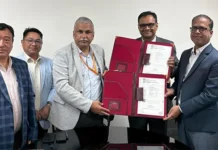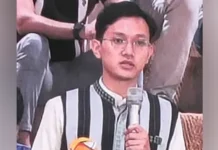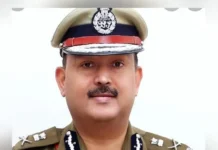Suicide is one of the leading causes of death across the world. In India, according to the National Crime Records Bureau (NCRB), in 2022 1.71 lakh people died by suicide, equating to one death every minute. Different studies have shown that the suicide rate is increasing each year, with the young population, especially those aged between 15 and 29, particularly vulnerable. Unfortunately, suicide is often under reported because of various social stigmas, lack of awareness, and inadequate reporting systems.
In Arunachal Pradesh, the situation mirrors this national trend. An in-depth doctoral study by Dr Tarun Mene of the AITS, RGU, highlights the high and rising suicide rates in the Dibang valley, exacerbated by under reporting. His subsequent research papers argue that official data are undependable in understanding the trend. Though his study was conducted a decade ago, he argues that the situation has not changed. He stresses that lack of comprehensive research on suicide in the state, coupled with traditional and religious beliefs, perpetuates misconceptions and hinders open discussions on the issue. Currently he has undertaken a national-level research project titled ‘ICMR’s multi-state implementation research study on suicide risk reduction and improving mental wellbeing among school and college students’, in collaboration with the Indian Council for Medical Research, New Delhi, in Arunachal.
Globally, different studies reveal increasing suicide rates among the indigenous communities, especially among young males. These studies indicate that rapid structural transitions, such as in economy, politics, social relations, education system, religion, land, etc, in traditional societies increase stress and helplessness. Poor coping mechanisms and support system often lead to dependence on alcohol and substance abuse or, tragically, suicide.
Further, in Arunachal, suicide is a taboo subject, leading to stigmatisation and even ostracization of the affected families in some communities. Communities often label families negatively, attributing suicides to ‘evil spirits’ or ‘the devil’. These misconceptions hinder coping mechanisms for grieving families and discourage individuals from seeking professional help. Consequently, the stigma results in underreporting, impacting official records.
Suicide is avoidable and preventable when it is approached holistically. Different studies conducted in suicide burden states (states with high rates of suicide) in India show that media reporting is a critical yet under utilised strategy for suicide prevention. While irresponsible media reporting, such as over-publicised suicide – like in cases of unusual suicide – can lead to imitative suicidal behaviour, known as the Werther effect.
Indian media, particularly local outlets, often focus on sensationalism without providing educative content. Reports, including on social media platforms like Facebook and WhatsApp, frequently disclose the names, ages, methods, and locations of suicides, sometimes including photographs and videos of the deceased. In Arunachal, the recent media circulation of a young lady trying to jump off a hanging bridge is an extreme example of such a case. Such reporting is unjustifiable and unethical, while a few others adhere to best practices like providing helpline details or linking mental health issues. Very often it is observed that, even authorities such as the police and the medical department, are not aware of the responsible and ethical guidelines while briefing or addressing the media. Similarly, various CBOs and NGOs do not follow prescribed guidelines while giving media briefing during press conferences. Therefore, in these situations, media agencies and reporters play a greater role in how they present the information/news.
The World Health Organisation (WHO) provides essential guidelines for responsible reporting by media professionals, considering the important role that media could play in suicide prevention strategy. These include:
# Avoid sensationalising suicide, making it front page content, and choosing appropriate and neutral titles. Particular caution should be used when reporting celebrity suicides.
# Do not describe the method, if necessary then avoid placing it in headlines.
# Avoid using words or terms that normalise, romanticise, or glorify suicide – for example, the Sati system in the past, self-immolation, patriotic suicide, etc.
# Avoid intrusive reporting and avoid using names, locations, photos, or videos, and respect privacy. Seek consent before publishing personal information and stories.
# Focus on preventive and educative reporting, such as providing information on suicide prevention, and detection, available support and resources such as the Tele-MANASH helpline, and discussion about multiple and larger causes of suicide. Discussion on mental health resilience and coping strategies against stressors are important.
# Stigmatising language: An online news portal used the phrase ‘committed suicide’ in a report about a student’s death. This terminology carries connotations of criminality and can reinforce negative stigmas surrounding mental health issues. A more sensitive choice of words would be ‘died by suicide’, which does not imply wrongdoing and is more in line with the WHO guidelines.
It is essential for both the general public and responsible members of society to adopt these guidelines. With widespread access to mobile phones equipped with cameras and the rapid sharing on social media, uncontrolled circulation of sensitive content is common. Therefore, adhering to responsible behaviour and following ethical practices is crucial.
Stigma surrounding suicide prevents individuals from seeking help and discussing their struggles. Media and community leaders must collaborate to break this silence. Media can share stories of hope and recovery, highlight the importance of mental health care, and encourage open discussions. Community leaders can speak out against stigma and promote mental wellbeing.
Suicide prevention requires a holistic approach, emphasising mental and emotional resilience with strong support systems around, such as a robust network of family, friends, peers, teachers, and trained professionals. Government and non-government agencies must collaborate to develop resources addressing mental health issues. By breaking the stigma, raising awareness, and improving access to mental health services, we can work towards a society where individuals feel supported and valued, and where suicide is no longer a leading cause of death. Responsible reporting can save lives and foster a more compassionate and understanding society. (The author is a project research scientist in ‘Multi-state implementation research study on suicide risk reduction and improving mental wellbeing among school and college students’, under the Indian Council for Medical Research in Arunachal.)





